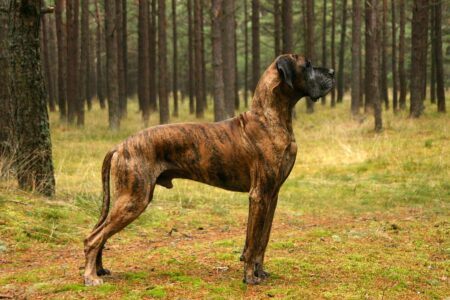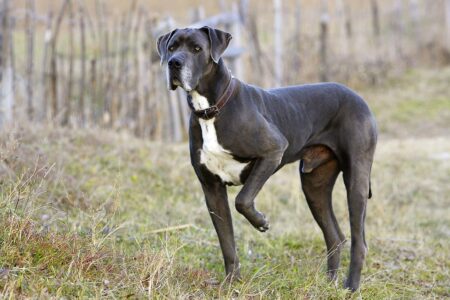
European Great Dane: A Striking Majestic Dog
The European Great Dane! Also known as the German Mastiff or Deutsche Dogge is a dog breed known for its tall, statuesque stature, noble demeanor, and loving personality. Traced back to its origin in Germany, the Great Dane was originally bred for hunting large game like boar and deer but over the centuries, they became a beloved companion for royals and aristocrats which has earned them the nickname “Apollo of Dogs.” Today, the European Great Dane is a popular family pet and show dog famous for its gentle, loyal nature. Read on to learn all about this rare and majestic dog breed.
European Great Dane: Overview
Here’s a quick summary of the European Great Dane:
The European Great Dane is a large breed with an elegant appearance, affectionate nature, and a regal bearing.
Height:
They stand between 30-32 inches tall at the withers (shoulders) for males and 28-30 inches for females.
Weight:
Males weigh between 120-200 pounds and females weigh between 100-150 pounds.
Lifespan:
European Great Danes typically live for 8-10 years, although some may live longer with proper care.
Color:
European Great Danes come in a variety of colors, including brindle, fawn, blue, harlequin, and black.
Grooming:
Their short, smooth coat is easy to care for and doesn’t shed much. Regular brushing and bathing are recommended to keep the coat clean and healthy.
Exercise:
Despite their large size, European Great Danes don’t require a lot of exercise. A daily walk or play session will suffice, although puppies may need more activity to burn off energy.
Training:
European Great Danes are intelligent and eager to please, making them easy to train. However, they can be stubborn at times and require consistent and positive training methods.
Temperament:
They are friendly, affectionate, and good with children. They can be protective of their family and home but aren’t aggressive. They can be a bit of a couch potato and love to spend time with their family.
How Rare is A Great Dane?
European Great Danes are not as rare as some other dog breeds, but they’re certainly not as common as more popular breeds like Labrador Retrievers or Beagles.
Here’s how their rarity breaks down:
- Worldwide population: There’s no exact estimate of the worldwide population of European Great Danes, but they’re not considered rare.
- In the United States: The European Great Dane is considered a rare breed by the American Kennel Club, with around 15,000 dogs registered each year.
Do European Great Danes Make Better Family Pets?
Yes, European Great Danes are indeed great family pets for the right family!
SEE ALSO: Chocolate French Bulldog: All You Need To Know
History of the European Great Dane
The history of the European Great Dane is long and fascinating. Here’s a quick rundown:
Ancestry: The Great Dane was developed in Germany, where it was used as a hunting dog for big game like wild boar and deer.
Early appearances: The breed was popular among German nobles and was featured in several paintings and drawings from the 16th to 18th centuries.
Rise in popularity: In the late 1800s, the breed was imported to England and became popular with English nobles the breed’s popularity continued to grow, and it was eventually introduced to the United States.
Characteristics of European Great Dane
Here are some of the characteristics that make the European Great Dane a unique breed:
- Size: The European Great Dane is a large breed, with males typically standing around 30 inches tall and females standing around 28 inches tall and they’re known for their tall and muscular stature.
- Coat: The coat of the European Great Dane is short, smooth, and dense and the coat comes in a variety of colors like fawn, brindle, blue, black, and harlequin.
- Temperament: European Great Danes are known for their gentle, friendly, and affectionate nature. They’re patient with children and other pets and make excellent family pets.
- Training: European Great Danes are intelligent and eager to please, which makes them easy to train. They respond well to positive reinforcement methods.
- Exercise needs: European Great Danes have moderate exercise needs and enjoy daily walks and playtime.
- Health: Like many large breeds, European Great Danes are prone to certain health conditions like hip dysplasia, bloat, and joint problems.
Physical Appearance of European Great Dane
The European Great Dane has a striking and regal appearance because of its muscular build, striking coat, and unique facial features like:
- Head: The head of the European Great Dane is long and powerful, with a wide muzzle and black nose. The ears are medium-sized and floppy, and the eyes are dark.
- Body: The body of the European Great Dane is long and muscular, with a deep chest and strong legs. The tail is long and straight.
- Coat: The coat of the European Great Dane is short and smooth, and comes in a variety of colors like fawn, brindle, blue, black, and harlequin (a pattern of white with black spots).
- Size and weight: The European Great Dane is a large breed, with males weighing around 120 to 200 pounds and females weighing around 100 to 150 pounds.
- Proportion: The European Great Dane has a proportionate appearance, with a broad chest, deep chest, and strong legs that give it an athletic and muscular look.
What is the Difference Between a European Great Dane and A Great Dane?
While European Great Danes and Great Danes are technically the same breed, some subtle differences set them apart:
- Physical appearance: European Great Danes tend to be larger and heavier than their American counterparts, with more of a square-shaped head and wider muzzle.
- Coat colors: European Great Danes have a wider range of coat colors, including harlequin (a pattern of white with black spots) and blue, which is less common in American Great Danes.
- Temperament: European Great Danes are often described as more laid-back and easygoing than American Great Danes, which can be more energetic and playful.
- Price: European Great Danes are considered more rare and valuable, making them more expensive than American Great Danes.
- Health issues: European Great Danes are prone to some health issues like joint problems and bloat, which can be more prevalent in larger and heavier dogs.
American vs European Great Dane
Let’s break down the differences between the American and European Great Dane:
- Size: American Great Danes tend to be slightly smaller than European Great Danes, with males standing around 28 to 32 inches tall and females standing around 26 to 30 inches tall.
- Coat: American Great Danes have a slightly shorter and sleeker coat compared to their European counterparts.
- Color: American Great Danes are often fawn or brindle in color, while European Great Danes have a wider range of colors, including blue and harlequin.
Cost of European Great Dane
European Great Danes are considered a rare and valuable breed, so their price can be significantly higher than other dog breeds. Here’s a general range of prices you might expect to pay:
Puppies from a reputable breeder: $2,000 to $5,000 or more. Top-quality puppies from champion bloodlines can be even more expensive.
Adult dogs: Adult European Great Danes from a reputable breeder can range from $1,000 to $3,000 or more, depending on the dog’s lineage and training.
Health Problems of European Great Dane
Like many large breed dogs, European Great Danes are prone to certain health issues. Here are some common health problems to be aware of:
- Hip dysplasia: A condition where the hip joint doesn’t fit together correctly, causing pain and lameness.
- Bloat: Also known as gastric dilatation-volvulus, this is a life-threatening condition where the stomach becomes distended with gas and can twist on itself.
- Cardiac issues: European Great Danes are prone to heart conditions like cardiomyopathy, which is a disease of the heart muscle.
- Joint issues: European Great Danes can suffer from elbow dysplasia, a degenerative joint disease that can lead to lameness and pain in the elbow joint.
- Skin issues: Some European Great Danes can suffer from skin conditions like allergies and hot spots, which can cause itching and irritation.
- Eye problems: Some European Great Danes can develop eye problems like entropion (inward-rolling eyelids) and cataracts (clouding of the lens in the eye).
How to Care for European Great Dane
Here are some tips for caring for your European Great Dane:
- Diet: Feed your dog a high-quality, balanced diet that meets their nutritional needs. Consult with your vet for recommendations.
- Exercise: Provide daily exercise like walks, playtime, and mental stimulation to keep your dog healthy and happy.
- Grooming: Brush your dog’s coat regularly to remove dirt and loose hair. Bathe them as needed, but avoid bathing them too often, as this can dry out their skin.
- Veterinary care: Schedule regular check-ups with your vet to stay on top of potential health issues and receive vaccinations and preventive care.
- Training: Use positive reinforcement methods to train your dog as this will help establish boundaries and build a bond between you and your dog.
- Socialization: Introduce your dog to new people, animals, and environments from a young age to help them become well-rounded and confident.
- Safety: Protect your dog from hazards like extreme heat, parasites, and poisons.
Feeding Requirements for European Great Dane
Here are some food requirements for your European Great Dane:
- Protein: Choose lean sources of protein like chicken, turkey, fish, and eggs to support muscle health and growth.
- Carbohydrates: Whole grains like brown rice, oats, and quinoa are good sources of complex carbohydrates that provide sustained energy.
- Fruits and vegetables: Add fresh or lightly cooked fruits and vegetables like carrots, apples, and green beans to your dog’s diet for added nutrients and fiber.
SEE ALSO: Blue Merle French Bulldog: All You Need To Know
FAQs
Q. Is a Great Dane an aggressive dog?
No, Great Danes, including European Great Danes, are generally not considered aggressive dogs and they have a reputation for being gentle, loving, and affectionate.
Q. What are Great Danes known for?
Great Danes are known for their courage, friendliness, dependability, and elegant appearance.
Q. How big is a European Great Dane?
Great Danes have standing heights of 30″ to 32″ while females with a withers height of 28” to 30”. Males weigh between 120 to 200 pounds while females weigh from 100 to 150 pounds.
Q. What color Great Dane is most expensive?
European Great Danes come in a variety of colors, but the rarest and most expensive color is the harlequin pattern. This pattern consists of a white base coat with black patches, and it’s considered highly desirable in the show ring.


